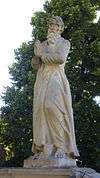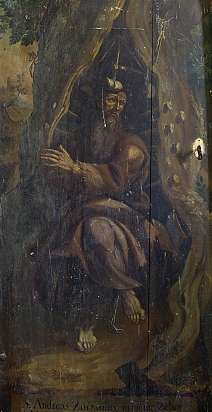Andrew Zorard
Saint Andrew Zorard (Polish: Andrzej Świerad, Żurawek, Żórawek, Świrad, and Wszechrad; Slovak: Svorad, Czech: Sverad; German: Zoërard, Latin: Zoerardus) was a Benedictine monk, now venerated as a saint.
Saint Andrew Zorard | |
|---|---|
 | |
| Born | c. 980 Opatowiec, Kazimierza, Poland |
| Died | c. 1009 Mount Zobor, Tribeč, Kingdom of Hungary (today: Slovakia) |
| Venerated in | Roman Catholic Church Eastern Orthodox Church[1] |
| Canonized | 1083 by Pope Gregory VII |
| Major shrine | St. Emmeram's Cathedral |
| Feast | June 13 (in Poland), July 17 (in Slovakia) |
| Patronage | Hungary, Diocese of Nitra, Diocese of Tarnów, St. Andrew Abbey in Cleveland |
Life
Zorard was born around 980 in Opatowiec, a small village in Poland. A tradition in the small village of Tropie holds that in his youth he lived near there as a monk. At around the year 1000, at about the age of 20, he began living as a hermit and a missionary, evangelizing in Olawa, Silesia (modern Poland). At some time, he also traveled to northern Hungary (Slovakia)
Around the year 1003 Zorard settled in Hungary, becoming a Benedictine monk at the St. Hippolytus Monastery on Mount Zobor near Nitra - then part of the Kingdom of Hungary. [2] He took the name "Andrew". There he became the spiritual guide of Benedict of Szkalka. Andrew and Benedict, with the permission of their superior Philip, later left the monastery and became hermits in a cave along the Vág River near Trenčín in modern Skalka nad Váhom. Andrew died of natural causes around 1009. He practiced such severe austerities that, according to legend, the iron chain, which he wore wrapped around the belt, eventually grew into his body.[2]
Benedict continued to live in the cave for three years until he was murdered by a gang of thieves looking for treasure. In 1083 Andrew's relics were transferred to St. Emmeram's Cathedral in Nitra where they remain to this day. A biography of Benedict and Andrew was written by St. Maurus, Bishop of Pécs, in which it says that Svorad led a hermit life living in a small cave near the monastery. The cave has since been called Svoradova.
Feast Day and veneration

Andrew is venerated especially in Slovakia, Hungary, and Poland, but also in the United States. His feast day is 17 July, but in some calendars he is venerated together with Benedict on 13 June.
King Géza I of Hungary declared him one of the patron saints of Hungary.
Andrew died around 1009. Duke Geza of Nitra, as early as 1064, took the first steps towards his canonization, although this first Slovak cult of the saint was officially confirmed in July 1083 by Pope Gregory VII, thanks to the Hungarian King Ladislaus I. Andrew's remains are stored in the St. Emmeram's Cathedral in Nitra.
References
- Phillips, Fr Andrew. "Latin Saints of the Orthodox Patriarchate of Rome". orthodoxengland.org.uk. Retrieved 2017-12-30.
- "Santi Andrea Zoerard e Benedetto su santiebeati.it". Santiebeati.it. Retrieved 2018-02-12.
Further reading
- Hoffmann H.: Die Heilige Zoerad. Archiv für schlesische Kirchengeschichte 3. 1938, p. 283-286.
- Semkowicz Władysław: Andrzej Świerad. In: Polski Słownik Biograficzny. Vol. 1. 1935, p. 100-101.
- Silnicki T.: Dzieje Kościoła na Śląsku. Warszawa 1953, p. 25, 94.
- Wędzki Andrzej: Andrzej-Świerad. In: Słownik Starożytności Słowiańskich. Vol. 1961, p. 24-25.
- Wojciechowski Tadeusz: Eremici reguły św. Romualda. In: Szkice historyczne XI wieku. Kraków 1904, p. 53-58.
External links
- Saint Benedict of Szkalka at Patron Saints Index
- Andreas Zorard (in Norwegian)
- Svorad and Benedikt (in Polish)